Contents
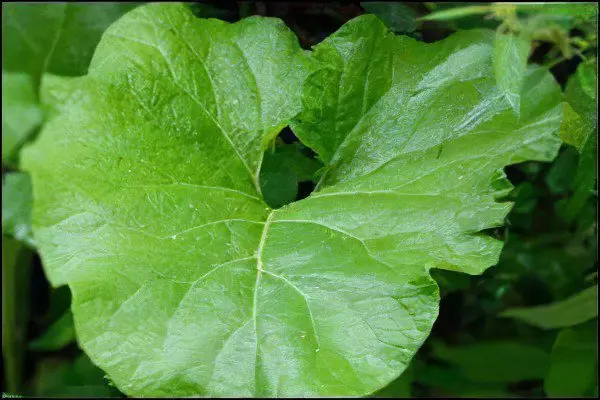
Burdock is a plant known to everyone, but few people know about its valuable properties. Beekeepers appreciate it as a honey plant. Cooks prepare broths, salads, all kinds of drinks from burdock. The use of the plant in folk medicine is so diverse that it has attracted the attention of doctors and scientists. Why is burdock so remarkable, how to use its properties for health benefits? Let’s look for answers to these questions together.
What exactly is used and in what form?

The composition of medical recipes includes almost all parts of burdock – roots, seeds, leaves. Decoctions, infusions, liquid extracts are prepared from burdock root. Quite often it is used fresh or in crushed, powdered form.
Burdock root is insisted on olive or almond oil, so the well-known burdock oil is obtained. The root of the plant is often added to various ointments, infusions, herbal teas. Homeopaths use fresh burdock root.
Burdock leaf juice is prescribed for dermatological problems. Burdock leaves are often the main components of compresses, lotions, and are also used to prepare medicinal decoctions.
What diseases are burdock used for?

Burdock root is part of the diuretic, diaphoretic, choleretic drugs. The active substances of the plant have disinfecting properties, promote the production of glycogen in the liver, and stimulate metabolic processes. Phyto compounds accelerate the synthesis of proteolytic enzymes, activate the insulin-forming mechanism.
From the root of burdock, decoctions and infusions are prepared, which are included in the complex treatment of many diseases:
Gout.
Rheumatism, accompanied by damage to the joints.
Diabetes mellitus.
The formation of stones in the kidneys, gallbladder.
Gastritis.
Peptic ulcer of the stomach.
Constipation.
Acne eruptions.
Hemorrhoids.
Rickets.
Freshly squeezed burdock juice is recognized as an effective remedy for dermatological diseases, skin wounds, malignant skin tumors. In gynecology, burdock is valued for delaying menstruation. The young leaves of the plant have antimicrobial properties.
The benefits of burdock
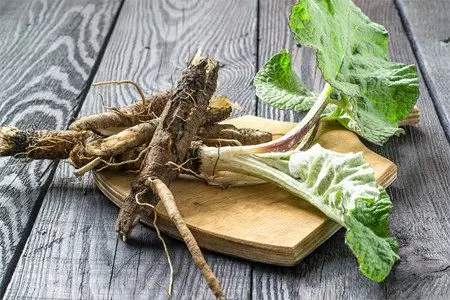
The centuries-old experience of using burdock in folk medicine and the data of modern research indicate the exceptional value of the plant on the human body. When used orally and externally, burdock realizes a number of useful properties due to the high concentration of natural polysaccharides, tannins and mucous substances.
The following effects of burdock have been confirmed:
Diuretic.
Diaphoretic.
Hypoglycemic.
Antihistamine.
Choleretic.
Antiseptic.
Healing.
Anti-inflammatory.
Laxative.
Burdock polysaccharides, namely inulin, have the qualities of insulin synthesized by human pancreatic cells. Inulin increases the function of cells to absorb glucose, while reducing its level in the blood. The same substance is of particular value for the intestines due to its ability to regulate the metabolism of fats, carbohydrates, and improve the quality of the intestinal microbiota. In the process of intestinal digestion, inulin binds to toxic, toxic substances and accelerates the process of their excretion from the body.
Due to the presence of high concentrations of tannins in the composition of burdock, the hemostatic and wound healing effect of the plant is realized. Plant mucus protects the sensitive mucous membranes of the digestive tract.
Burdock roots have diuretic, choleretic, diaphoretic and mild analgesic properties. The root acts as a mild laxative, improves skin condition. In addition, it has antimicrobial, antiseptic and disinfectant properties, relieves itching and allergic manifestations.
Burdock has anti-inflammatory, wound healing and anti-diabetic properties.
7 Scientifically Proven Medicinal Benefits of Burdock
1 Has a detoxifying effect
In folk medicine recipes, burdock is used to purify the blood. Scientific experiments have confirmed that burdock root contains active substances that bind to toxins in the bloodstream and remove them from the body.
Empirically, we managed to find out that burdock root cleanses the blood, stimulates blood supply in the upper layers of the skin.
2 Inhibits the growth of certain types of cancerous tumors
In parallel with the detoxifying properties, scientists have found that burdock inhibits the growth of malignant cells in certain types of cancer. In the course of one of the experiments, the ability of burdock to inhibit the development of pancreatic carcinoma was confirmed. [1].
Despite the proven antitumor activity of burdock, there is currently no registered drug against cancer based on it. “Miracle cures” offered by unscrupulous sellers are not effective in treating cancer. Moreover, some of them can provoke the growth of tumors.
Research on the antitumor properties of burdock continues to the present. Scientists believe that there is some promise in the treatment of various types of cancer [2], [3], [4].
3 Has aphrodisiac properties
A laboratory study has shown that burdock can have aphrodisiac effects. It turned out that in male rats, after the introduction of burdock extract, sexual behavior became more active, and there was also an increase in sexual function. [5].
The study of the discovered effect is ongoing. Scientists are planning to conduct experiments with the participation of people.
4 Helps in the treatment of skin diseases
External use of burdock decoction is used in the complex therapy of skin diseases, eczema, and various rashes. The active substances of the plant root have anti-inflammatory, antibacterial properties, which facilitates the solution of various skin problems. [6].
The results of one of the studies have been published that indicate that applying burdock extract to the skin helps in the treatment of burns. [7].
5 May relieve diabetes
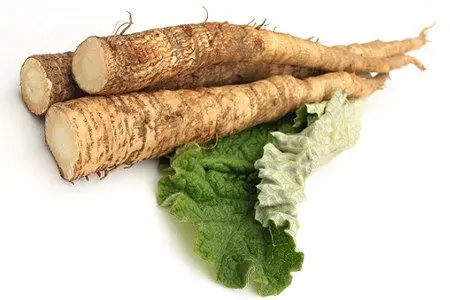
In 2017, the results of an experiment involving mice with diabetes were published. The animals received 200 to 300 mg of burdock root extract daily for a month. Observations showed an increase in the concentration of own insulin, maintaining a constant body weight [8].
These data confirmed the results of an earlier experiment conducted in 2014. Then scientists also suggested that burdock can alleviate the course of diabetes. [9].
6 Reduces cholesterol
There is evidence that burdock root extract has a positive effect on blood lipid profile. A study in laboratory animals has shown that regular consumption of the extract helps reduce total cholesterol, low-density lipoprotein and triglycerides. At the same time, all individuals showed an increase in high-density lipoprotein (“good” cholesterol) [10].
The researchers attributed the effect to the presence in the burdock root of genes involved in fat metabolism. Due to the mechanism of gene modulation, weight loss and a drop in cholesterol levels occurred in laboratory mice.
7 Restores the liver
In 2002, a study was conducted with the participation of laboratory rats. Previously, the animals were recorded alcoholic liver damage, provoked by high doses of ethanol. The rats received high doses of burdock extract daily. Control tests showed recovery of damaged liver cells [11].
Another animal study showed that burdock extract protected hepatocytes from the toxic effects of non-steroidal anti-inflammatory drugs. [12].
The chemical composition of burdock
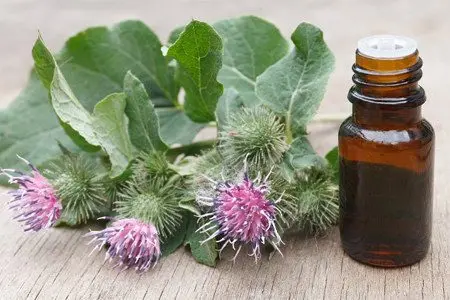
The chemical composition of different parts of burdock has some differences. In the root of the plant is fixed:
45% inulin.
12,5% protein.
0,17% bardan oil.
The study of the composition of burdock showed that all parts of the plant contain the strongest antioxidant compounds, namely, quercetin, luteolin, phenolic acids. Antioxidants are needed daily to protect cells from the effects of free radicals. They play an important role in the prevention and treatment of a number of diseases. The antioxidants in burdock help to manage the symptoms of inflammation. Scientists were able to prove that they lower pro-inflammatory markers in patients with osteoarthritis [13].
In addition, sterols, antibacterial compounds, vegetable acids (stearic, palmitic), tannins were found in the burdock root.
The composition of the leaves of the plant is dominated by tannins, essential oils, mucus. Arctiin glycoside was found in burdock seeds.
Used in cosmetics
Burdock is deservedly considered one of the favorite ingredients in cosmetic products. It is added to products for strengthening hair, eliminating dandruff. For this purpose, burdock oil, available in the pharmacy chain, is used. It is combined with decoctions of calendula, chamomile or hop cones.
Burdock for hair
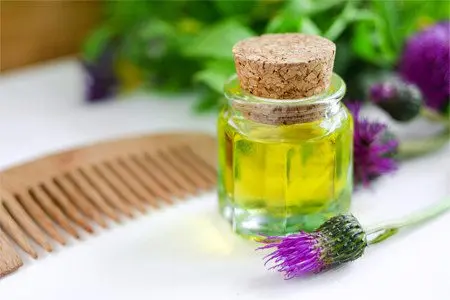
Probably, many people know how burdock roots have a beneficial effect on hair. Burdock strengthens hair, gives it strength, beauty and silkiness. Burdock oil (burdock oil) has been considered one of the most effective hair restoration products for hundreds of years. Rubbing it into the scalp showed a high result after hair loss during chemotherapy in cancer patients. The active substances of burdock penetrate directly to the hair follicles, nourish them, and accelerate hair growth.
To add shine to hair. To prepare such a remedy, you need to take one teaspoon of burdock oil, honey, onion juice and 10 grams of burdock juice + shampoo (it is recommended to use shampoo for dry hair). The resulting mixture should be applied to unwashed hair, put on a plastic cap and a warming cap on the head, leave for half an hour. After this time, the head should be washed with warm water and allowed to dry without using a hair dryer. You can also just rub fresh burdock juice into the scalp 2-3 times a week – and your hair will certainly please you.
To strengthen the hair, prepare a decoction of burdock. To do this, take:
2 tbsp. tablespoons crushed burdock roots.
200 ml water.
Plant materials are poured with water and kept in a water bath for 15 minutes. After that, the broth is cooled, filtered. After washing the hair with shampoo, a decoction of burdock is rubbed into the skin of the scalp. Additional rinsing with water is not required.
Popular hair balm with burdock, which is prepared from:
Burdock root.
Rhizomes of calamus.
Flowers of calendula.
Hop cones.
All components are taken one tablespoon, pour a liter of boiling water. The herbal mixture is kept in a water bath for 15-20 minutes. The broth is insisted, allowed to cool to a pleasant temperature, filtered. The product is used to rinse hair after traditional washing.
To improve the scalp and strengthen hair, you can use the following mixture of herbs:
Burdock.
Plantain.
Tumbles.
Hypericum
Nettle.
All components are taken in equal parts, mixed. To prepare a decoction, take three tablespoons of herbal collection, pour a liter of boiling water and put in a water bath. After that, the container with the broth is removed from the heat, cooled to an acceptable temperature and filtered. The prepared product is used after washing the hair as a rinse.
As a hair strengthening agent, a mixture of equal parts of crushed burdock roots and calamus roots is used. To prepare a decoction, take six tablespoons of the mixture, pour them with a liter of water. The composition is boiled for 15 minutes and left to infuse. The finished decoction is rubbed into the hair roots at least three times a week.
Based on a decoction of burdock, a firming mask is prepared, which also includes:
Cognac – 1 tbsp. a spoon.
Onion juice – 4 tbsp. spoons.
To these components add 6 tbsp. spoons of decoction of burdock roots. The mixture is thoroughly mixed. The composition is rubbed into the roots of the hair, wrap the head with a warm scarf. The mask is kept on the hair for about two hours, after which it is washed off.
Burdock for skin
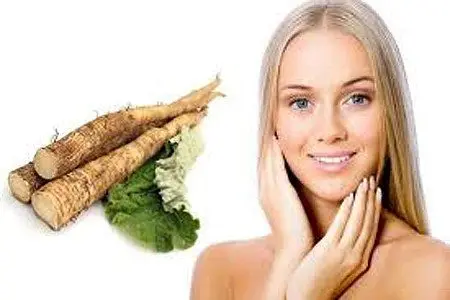
Owners of oily skin burdock helps to normalize the sebaceous glands. For this, a tablespoon of burdock roots is poured with a glass of boiling water. The composition is kept for at least 30 minutes, filtered. In the finished infusion, moisten a gauze napkin and apply to a cleansed face. After 10-15 minutes, the napkin is removed. Rinse your face additionally is not required.
For the treatment of acne, a decoction is prepared from equal parts of the roots of burdock and St. John’s wort. Two tablespoons of the collection are steamed with a glass of boiling water, put in a water bath for 15 minutes. The composition is cooled, filtered and used to wipe the areas of rashes 2-3 times a day.
Burdock Recipes
To get the maximum benefit, it is important to properly prepare herbal products. We offer the best burdock recipes.
Burdock juice
To get the most useful juice, burdock leaves are harvested in May. It is during this period that the greatest amount of biologically active substances is concentrated in them.
Burdock leaves are thoroughly washed, dried with a paper towel and passed through a meat grinder. The resulting mass is filtered through a double layer of gauze, poured into a jar. Take enough leaves to make 500 ml of juice. This volume is enough for a week with a three-time intake of one dessert spoon. Juice is taken 30 minutes before meals.
Internal intake of burdock juice is indicated for a kidney cyst, to strengthen immunity, normalize digestion. External use is effective for thermal skin lesions, wounds, bedsores. For the treatment of sinusitis, burdock juice is instilled into the nose.
[Video] 2 Unique Ways to Harvest Burdock Juice for Long-Term Storage:
Possible harm and contraindications
First of all, it is important to remember that the effects of burdock have not been sufficiently studied in relation to children. Pediatricians treat him with caution. Even if any burdock-based preparations are prescribed for children, their use is strictly under the supervision of a doctor.
Numerous studies have identified a number of potential risks that may accompany the use of burdock:
Burdock-based supplements are drunk without exceeding the recommended dosage. Reliable data on the use of high doses of burdock is not yet available.
For indoor and outdoor use, burdock is best bought from trusted vendors, pharmacies or health shops. Collecting the plant in the wild is not recommended due to its external resemblance to the poisonous belladonna, which belongs to the nightshade family. In nature, these plants often grow side by side.
Burdock root is strictly forbidden to take with symptoms of dehydration. The plant has a pronounced diuretic effect, so it can aggravate the condition of the body. Due to these properties, burdock is not taken along with other diuretic herbs or diuretic drugs.
People who have experienced symptoms of allergies to daisies, chrysanthemums, burdock should be taken with caution. The plants belong to the same family, which means that the likelihood of an allergy to burdock supplements is very high.
Burdock is contraindicated in women at the stage of preparation for conception, as well as during pregnancy.
Types
In botany, 19 species of burdock are described, the most common of which are:
Burdock often called burdock. This species is found in the vastness of Asia, Europe, the Far East, India and even Africa. It is valued for its high melliferous qualities and is widely used in cooking and the production of medicines.
Burdock loves temperate regions of Europe and Western Asia.
Burdock felt or cobweb – an edible plant common in Central Asia, Siberia, China, Europe. Burdock root oil is used in cosmetology.
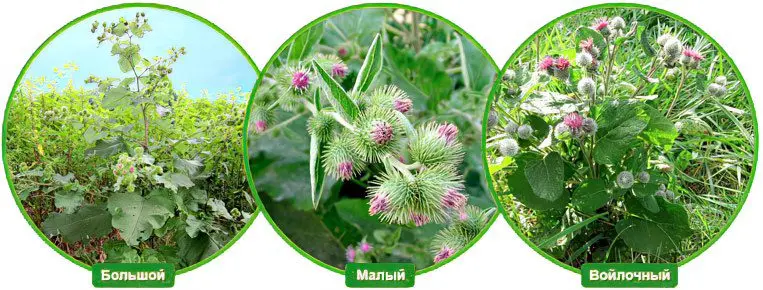
The largest variety is large burdock, which is a herbaceous bush, reaching a height of up to a meter. The burdock root is quite large, extending into the depth of the soil up to 50 cm, fleshy, shaped like a spindle. The shoots of the plant are straight, covered with fluff. The upper part of the burdock is branched. The largest leaves are located at the bottom of the plant, they become smaller upwards. The shape of the leaves can be described as ovoid or heart-shaped. The upper surface of the leaf plate is green, the upper surface is gray, with a felt shade. Burdock blooms from July to early autumn, purple flowers appear on the tops of the shoots, which are collected in rounded baskets. Seed maturation takes place until the end of October.
Usually burdock is perceived as a weed. He is met on roadsides, wastelands, in fields, in the area of reservoirs. Several plants can form quite picturesque thickets.
Rules of raw material procurement
In order to get the maximum benefit from the use of burdock, it is important to properly prepare medicinal raw materials.
Experts recommend following certain rules:
Dig up the root of the annual burdock no earlier than September-October. Biennial plants retain all their useful properties, but they are dug up at the very beginning of spring before the first shoots appear.
The tops of the stems of burdock are harvested during the flowering period. A specific interval cannot be set, it depends on the climate conditions. As a rule, burdock flowers are harvested during the summer.
Immediately after digging, the roots are cleaned of soil residues, washed thoroughly, peeled off, and thin shoots are immediately cut off. The prepared root is cut into pieces up to 10 cm.
Burdock root is laid out on a flat surface in one layer. Dry outside, protected from direct sunlight, or in a well-ventilated room. The finished dry root acquires a brown color, and inside it becomes grayish. When drying the leaves, the same conditions are observed.
Dried plant materials are collected in paper bags, boxes or linen bags. Store the collected burdock in a dry, dark place. The shelf life of the leaves of the plant is no more than two years, the roots – up to five years.
It should be borne in mind that in the first year of its life, by the end of the growing season, all useful and nutritious substances accumulate in the root, so the root at this time is very juicy and fleshy.
The accumulated supply of nutrients begins to be spent in the second year of the plant’s life. Nutrients are spent on the formation of the stem, the root becomes flabby, woody and is no longer suitable for medicinal and culinary purposes.
[Video] Useful properties of burdock, collection rules, harvesting nuances:









